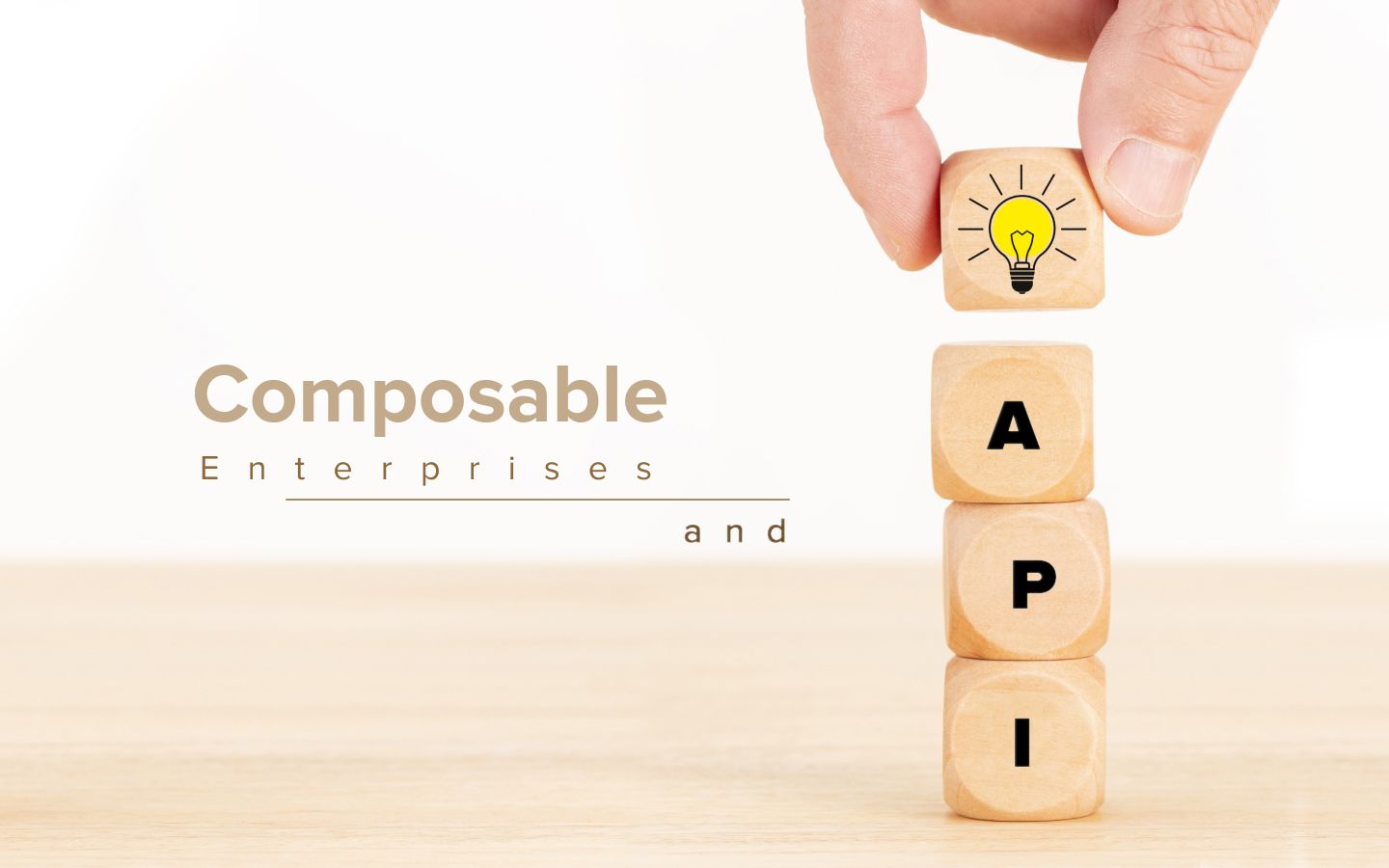In our last article we talked about "what is composable enterprise, its essential parts, goals and characteristics." Now lets delve deeper into it with APIs!

The importance of APIs and API management systems in a composable enterprise
As per Global API Management Market Analysis, the API market size is speculated to grow to $6.81 billion by 2025.
The traditional way of marketing nonchalantly forces businesses to choose compatible tools even if they were not the best fit. The marketers used to inculcate ESB (Enterprise Service Bus) which prevented other mechanisms from integrating properly with their solutions. It often acted as a bottleneck, as you had to decide your additions based on what you already own.
The API integration is changing the world altogether, and for good. Today, every application focuses on flexibility as its primary idea. It allows them to integrate a flurry of tools easily and eliminate confusion existing in the traditional approach.
Here is how APIs management systems are eliminating the redundant roadblocks in a composable enterprise landscape –
- Monitoring and updating outdated API formats and converting them to REST API.
- Continuous tracking of API and application performance.
- Using third-party tools to standardize security authentication.
- Developing a catalogue of working APIs to enable easy access, review, and search.
- Setting up and standardizing security authentication throughout the enterprise.
A composable enterprise is not merely about technology. It also encompasses people and process.
Technology is directionless if the people aren’t capable enough to use it the right way. You require someone to steer even the most powerful ship in this world to its destination. It is the same in a composable environment too. There are three main elements here – technology, people, and process.
The technology, in itself, is a demanding one. If you are adopting it, you will have to remodel most strategies you had been using all this while. One primary example to understand would be a few years old IT infrastructure not having support for API-based composable enterprises. Most of these would require additional equipment to support it or will be deemed redundant.
IT leaders and the workforce paves the way for the business to inculcate the latest technology to leverage its potential. The process includes looking for probable use cases, designing new products that streamline the entire workflow and encouraging people to perform to their potential.
Our previous generations missed out on building business processes that would find relevance in the future. We can take a cue from them and ensure that we do not repeat the same. If we want to do better, we will have to adopt the idea of composable enterprise – a world where you do not have to change the entire vehicle just because any of its parts went berserk.
For that to happen, we will need an architecture laced with the following –
Accessible enterprise data layer
It is imperative for a composable enterprise architecture to aid the decision-makers and higher authorities to achieve the above-mentioned goals of a composable enterprise. The architecture will have to bifurcate the cream, i.e., filtering the data sources to achieve the desired results from everything else that they do not require. The segregated data should be integrated into the data flow to make them accessible and standardized.
High on adaptability
The modern-day environment demands impeccable software support irrespective of the device the workforce uses.
On-demand scalability
As we harp on modularity, it becomes imperative for a composable enterprise to scale on demand. The main aim of any business is to grow. As they expand, so will their service and other infrastructure requirements.
Automation capabilities
On-demand services can be a genuine success only when you eliminate manual intervention. Composable enterprise architecture’s primary focus is getting rid of scripting and making every process available 24*7.
Self-service
The new-age architecture comes with self-service capabilities, i.e., key personnel should be able to access critical applications and data on their own. It would cut down on downtime and enable the business to continue as usual. It gets rid of the rigidity plaguing the traditional architecture.
Service-oriented
Another critical component of composable enterprise architecture is the reusability and loosely connected microservices. It would ensure that you can tweak vital functions and applications to remain in sync with the requisite business functions.
Architectural leadership for the composable enterprise
Before the introduction of the cloud in the business landscape, IT was much simpler and manageable. There was an abundance of middleware that connected a host of acquired software. But we are gradually experiencing the death of centralized IT. The latest trends revolve around a well-thought-out distributed IT ecosystem.
Even though there are several challenges on the way, the prospects seem much more viable. There is a greater focus on making everything customer-centric. What is the result? There is an increased pressure of having to meet the customer demands across the board. It has also empowered the users and allowed them to make informed decisions.
The inculcation of APIs has allowed organizations to provide value throughout their value chain. It has also allowed them to maintain a favorable relationship with their stakeholders.
When it comes to enterprise composability, APIs support both internal and external procedures. The former helps in leveraging the overall team endeavor, whereas the latter allows customers to mix and match to find the correct information at the right time. APIs will enable them to compose and recompose in real-time and draw information from multiple sources.
It positions architecture as one of the critical enablers of the composable enterprise reality. But to do that, API designers must also remember the need to ace the non-functional requirements, such as security and compliance. It would require the IT team to build an intuitive, web-centric architecture first and then plan on executing the composable enterprise idea.
Another aspect we harp on with composable enterprise is decentralization. But IT is not everyone’s cup of tea, by default. So the team has to build an app store or something similar that can house all the templates and other vital data. It would gradually bring about the habit of self-service, which would then free the IT department of redundant tasks and allow them to focus on their core competencies.
Challenges with implementing composable enterprise
Today, a ready-made application often falls short of expectations. It is the reason we see the demand for composable enterprise being at an all-time high. But when there is such a maddening demand, it also brings about a host of challenges.
Here are the issues that you can come across in your tryst to become a composable enterprise-
Finding the right balance
When you have so much to fiddle with, you can inadvertently end up overcooking and making it a mess. The last few years saw the rise of microservices and REST APIs. These have ensured that composable enterprise is no longer a directionless dream. But it has been criticized for being too vocal and not having enough results to show. So it is imperative for businesses to find a middle ground while building and integrating the packaged applications.
A packaged application refers to a group of APIs and entities that are serving a single business capability. These are mini-applications that are dynamic and easily scalable. But hiring multiple teams in managing them can often lead to friction. So it is imperative to let a single business team work it out independently for the best results.
Managing multiple packaged application and ensuring they are all in sync
The composable enterprise is about performance coupled with agility. It includes a group of packaged applications, each of which is separately managed. But these are all linked, interoperable, and have common security and analytics needs. So it can often be an arduous task to manage them simultaneously.
Semantic barriers
A composable enterprise is a decentralized organization. We see more businesses coming up with ‘innovation teams’ to help them adopt it. Although positive, behavioral, and semantic barriers have the potential to disrupt plans with ease. It means that even though we visualize everyone as one, it is practically tough to implement.
Not to forget, the presence of semantic or language barriers is further worsening the situation. It can lead to a disconnect between the teams or their members. Many businesses have started conducting cultural transformation programs and hand-coding certain aspects of what they are trying to create to tackle the glaring issues.
Partner with Quickwork to turn your composable enterprise dream into reality
Gartner predicts that composable enterprise would be one of the top trends for 2021.
The IT landscape’s massive strides have promoted it from being a back-office sidekick to a full-fledged partner of every business.
The world of composable enterprise is exciting. The ability to be modular and shift strategies in real-time gives businesses an edge and a better chance to minimize losses. It also presents a unique opportunity to make the most of the resources.
About Quickwork
At Quickwork, we are looking to democratize automation and make it more accessible. We harp on giving you control and make everything more accessible. So we have brought about automation on the cloud, enabling you to access critical information on the go. Add to that the lack of any coding throughout the time you partner with us. We are looking to make it all super convenient for you and your workforce.
Click here to understand more about our offerings and how we are looking to revamp the way businesses understand IT.









